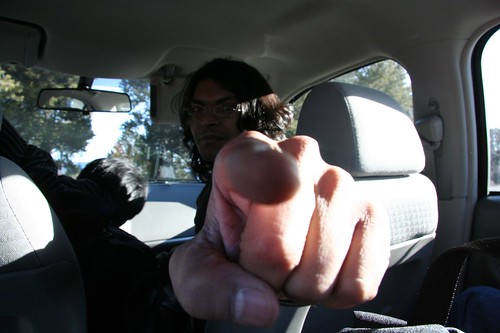The usual steps in installing a font :
1. Copy the ttf files to a directory
2. sudo mkfontscale - this generate an X11 font name for each of the fonts found in the directory. This info would be written into a fonts.scale file in the directory.
3. sudo mkfontdir - creates an index of X Font files in the directory and writes it into a fonts.dir file in the same directory.
4. sudo fc-cache -fv - this creates a font information caches for fontconfig systems. this enables application that uses fontconfig to load fonts more quickly.
But usually when adding new fonts, I just copy the fonts to ~/.fonts/ directory and run fc-cache -fv. These though would be available only for one user on the system.
Saturday, June 23, 2007
Wednesday, June 06, 2007
Disable Touchpad while typing
Check out this link to disable the Touchpad. http://ubuntu.wordpress.com/2006/03/24/disable-synaptics-touchpad/
I tried it, but kept getting this error:
libu@toxicware:~$ synclient TouchpadOff=1
Can't access shared memory area. SHMConfig disabled?
I did add the SHMConfig option in the xorg file, but I guess I might have to restart the X server. But since I had other things running, I decided to put this off for another day ;) !! So till then.
I tried it, but kept getting this error:
libu@toxicware:~$ synclient TouchpadOff=1
Can't access shared memory area. SHMConfig disabled?
I did add the SHMConfig option in the xorg file, but I guess I might have to restart the X server. But since I had other things running, I decided to put this off for another day ;) !! So till then.
Tuesday, June 05, 2007
synclient daemon
Read on the web about synclient daemon. This helps to control the Synaptics Touchpad. Have to check this out to see whether I can make it work some way or the other.
GPLv3 License
Richard Stallman has given a write-up on why people should use or if they were using GPL ver 2, should upgrade to GPL ver 3. Below I have tried to surmise as best as I can and also my thoughts.
1. GPLv2 will remain as is and programs have the option of remaining under that license.
2. GPLv2 and GPLv3 code cannot be combined to form a new program. But GPLv2 and GPLv3 programs can coexist together on a system.
3. GPLv3 will block the "tivoization" of computers. TiVo uses GPL covered software, but the appliance shuts down when it detects modified software.
4. It ensures you are free to remove the handcuffs imposed by DRM. In Stallman's words
6. It provides for explicit patent protection of the users from the programs contributors and re-distributors.
7. Further advantages of GPLv3 include better internationalization, gentler termination, support for BitTorrent, and compatibility with the Apache license.
Stallman has this dream of getting software patents abolished or protect users from them so as to render the patents void.. Software patents are nasty alright, it has this capacity to dull creativity and to a large extend throttle software evolution.
Quoting from the article by Stallman:
1. GPLv2 will remain as is and programs have the option of remaining under that license.
2. GPLv2 and GPLv3 code cannot be combined to form a new program. But GPLv2 and GPLv3 programs can coexist together on a system.
3. GPLv3 will block the "tivoization" of computers. TiVo uses GPL covered software, but the appliance shuts down when it detects modified software.
4. It ensures you are free to remove the handcuffs imposed by DRM. In Stallman's words
"..it makes sure that you are just as free to remove nasty features as the distributor of your copy was to add them."5. It also resists the threat of patent deals like Novell-M$ deal. Releasing a program under GPLv3 protects it from future Microsoft's future attempts to make redistributors collect royalties from program's users.
6. It provides for explicit patent protection of the users from the programs contributors and re-distributors.
7. Further advantages of GPLv3 include better internationalization, gentler termination, support for BitTorrent, and compatibility with the Apache license.
Stallman has this dream of getting software patents abolished or protect users from them so as to render the patents void.. Software patents are nasty alright, it has this capacity to dull creativity and to a large extend throttle software evolution.
Quoting from the article by Stallman:
The only way to make software development safe is to abolish software patents, and we aim to achieve this some day. But we cannot do this through a software license. Any program, free or not, can be killed by a software patent in the hands of an unrelated party, and the program's license cannot prevent that. Only court decisions or changes in patent law can make software development safe from patents. If we tried to do this with GPLv3, it would fail.
Labels:
Free Software Foundation,
FSF,
GPLv2,
GPLv3,
Software Patent,
Stallman
Subscribe to:
Comments (Atom)

